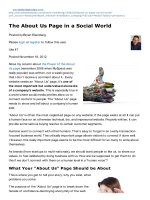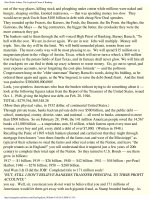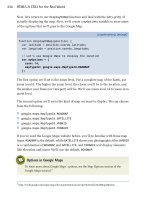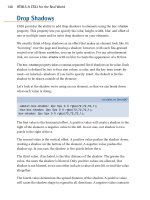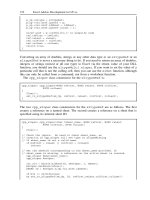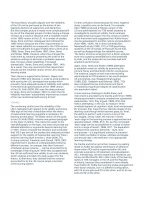wiley philanthropy in a flat world phần 5 pot
Bạn đang xem bản rút gọn của tài liệu. Xem và tải ngay bản đầy đủ của tài liệu tại đây (84.29 KB, 23 trang )
FLAT AND BEAUTIFUL
76
However, thousands of people are using this serv-
ice. They are logging on and transferring funds to other
people who appear to have a need. They are peer - to -
peer fundraising. There is no middleman. No third party.
No nonprofi t. Why they are doing this is a good ques-
tion, and one that would merit an in - depth study of
Modestneeds ’ donor motivations. However, I would
hazard a guess that actually most individuals have a
good soul, and want to make the world a better place.
And that, despite what the media and certain poli-
ticians would like us to believe, asking for someone ’ s
charity is something that the vast majority of human
beings do only when they really have no other choice.
It is not something most of us do easily, and as a result,
there is a fundamental fi ltering process happening. The
donors want to do good, and increasingly want to see
the tangible results of their gifts. They may even want
to create links with the benefi ciaries in a similar way to
being a child sponsor. And the benefi ciaries really need
the support and appreciate it.
Let ’ s be clear here; this is still a very minority activ-
ity . . . for the moment. At the time of writing, only
3,500 people have been helped by Modestneeds. But
The Realities of the Flat World
77
it is not the only web site providing such peer - to - peer
fundraising opportunities. I believe the fl at world is
going to be increasingly powerful in bringing together
individuals with needs and individuals with the capacity
to give — in other words, in bringing together the two
markets of nonprofi ts without the nonprofi t in the
middle. By cutting us out, the donor wins by ensur-
ing that all of his or her money goes to the benefi ciary.
And the benefi ciary wins by having the opportunity to
create a relationship with the donor.
It is safe to say we have not seen the end of this
trend.
Individualism
The world is a weird place, never quite easy to understand
and always full of surprises. Who would have thought,
for example, that in a world where we have almost
limitless choice, people would start to become more
individualistic?
But irony aside, huge choice is producing huge
individualism. Me has replaced any semblance of us in
many Western societies. Children spend more and more
FLAT AND BEAUTIFUL
78
hours in front of video games and on the Internet,
fulfi lling me needs rather than interacting with other
kids and building social and supportive communities.
Adults have taken things even further. Think of our
diffi culties in abandoning private cars in favor of pub-
lic transport, despite the fact that the average speed in
many cities these days is lower than it was when we
used horses and carts. Think of our desire to be consid-
ered by business and customer service centers as indi-
viduals. We have entered a world where we all want to
be considered in a segment of one: me!
The baby boom generation, which is moving mas-
sively toward retirement like an out - of - control ship
toward an iceberg, is the epitome of this incredible
hedonism. Travel companies in the United States spe-
cializing in the over - 50 markets now talk about pro-
posing SKI - ing holidays to their customers. Not such
a surprise, you may say. Over - 50s are now fi tter than
ever; why shouldn ’ t they enjoy heading down a moun-
tain every so often? Except the SKI - ing holidays that
these companies are referring to are Spending the Kids ’
Inheritance holidays. Welcome to the “ I ’ ve earned it,
I ’ m spending it ” generation.
The Realities of the Flat World
79
The chance to tap into this generational spending
spree does, of course, represent an incredible opportu-
nity for nonprofi ts. But we need to be smarter, sharper,
and more donor - centered to make this happen. Today,
how many nonprofi ts can realistically say that they treat
their supporters in segments of one? But tomorrow, if
we want a slice of this huge baby boomer chocolate and
cream cake with cherries on top, we are going to have
to fundamentally change our thinking and our practices.
Both Simone Joyaux (Beyond Fundraising, Wiley,
2005) and Kay Sprinkel Grace (Keep Your Donors,
Wiley, 2007) two of the most visionary leaders in non-
profi t thinking, have spoken and written at length on
how to develop donor - centered fundraising. This author
will not attempt to do even the palest imitation of
their work, but feels strongly that the huge value that
can be gained from putting the donor and supporter at
the heart of the organization — both fi guratively and in
reality — makes it worthwhile to read their books soon.
Tomorrow (and this should come as good news for
anti - globalizationers everywhere), global trade and eco-
nomics and development are going to be less and less in
the hands of the World Trade Organization, the World
FLAT AND BEAUTIFUL
80
Bank, and the G - 8. Individuals who have understood
the fl at world, who are adapting quickly to its processes
and technologies, and who are starting to innovate and
create value horizontally rather than through the tra-
ditional vertical organizations are going to be the ones
with the power. I ’ m afraid it ’ s true — the geeks really are
going to inherit the earth.
Back in the 1980s we had the yuppies, then
the NIMBYs (not in my backyard), and ever since a
plethora of abbreviations to try to systematize cultural
trends. However, the cultural trends of tomorrow are
all pointing toward a new group, a segment not of one
but of millions, who are positioning themselves today
to occupy some of the world ’ s most powerful positions
tomorrow. They are called the zippies, or as the Indian
weekly magazine Outlook calls them, “ Liberalization ’ s
Children. ” Thomas Friedman quotes the magazine ’ s
defi nition of a zippie as a “ young city or suburban
resident, between 15 and 25, with a zip in the stride.
Belongs to generation Z . . . . Cool, confi dent and crea-
tive. Seeks challenges, loves risks and shuns fear. ”
As cute as this may sound, it takes on a whole other
meaning when you consider that more than half of the
Indian population is under 25.
The Realities of the Flat World
81
The zippies, not just from India, but also from China,
from Eastern and Central Europe, even from Western
Europe and North America, will tomorrow not just
be running business and nonprofi t empires with new,
totally global models; it is entirely possible that they
will be directly infl uencing most of the vital ele-
ments of the planet ’ s economic and social makeup
in ways that tomorrow ’ s national leaders will only be
able to dream of. Through supply chaining, horizon-
tal collaboration, virtual networks, and the fl at world
Web platform, and by breaking down boundaries
between cultures and nations, these global village
children are going to be changing our perspectives
on our planet. Please fasten your seatbelt. We are
cleared for takeoff.
One of the trends underpinning the thinking behind
this book, as you will have already understood, is the
huge importance of the individual in the fl at world.
The responsibility is in our hands — not those of our
governments, of our society leaders, or of intellectuals.
When I was at school, we used to sing a hymn that
began “ He has the whole world in his hands, ” referring
to the power of the Almighty. Without wishing to offend
any religious sensibilities, there is a distinct possibility
FLAT AND BEAUTIFUL
82
that the children of tomorrow could be singing the same
song, but replacing He has by You have.
Alexander Bard and Jan S ö derqvist, authors of The
Global Empire, make some very interesting challenges to
the concept of the individual. According to their book,
as we become increasingly individualistic and concen-
trate more on our own personal satisfaction through
our choices, the traditional individual will eventually be
replaced by the slightly schizophrenic dividual. This is
someone who harbors a number of different person-
alities and who functions in various tribal networks,
according to biography rather than geography, and
defi nes traits of personality differently in each network.
I would like to argue that this change is already
happening, and in a big way. We already compart-
mentalize our physical lives into a number of different
boxes. We have work, with relationships with colleagues;
family, with relationships with our wives, husbands,
partners, and kids; sport, with relationships with golfi ng
or gym friends; volunteering, with relationships with
other volunteers or board members . . . .
Many of us take pleasure in segmenting our lives
in such a way. We want our family time away from
The Realities of the Flat World
83
our colleagues, and often have behavior and personal-
ity traits that are differentiated according to the various
networks we are in. The virtual world just allows us to
take this one stage further. As an interesting illustration
of this, let ’ s look at gender. Few of us change gender, or
give the impression of changing gender through physi-
cal presentation, according to our networks. It is pretty
unlikely that you will pretend to be a man at work, but
play golf as a woman. However, the Web and the fl at
world networks allow us to do this. We can be who-
ever we want to be behind the avatars of our Web per-
sonalities. We can be women or men, black or white,
big or small. Just look at Second Life (it is claimed that
a surprisingly large number of men use female avatars,
and vice versa, in online gaming and in Second Life
for example). Ultimately, the authors of The Global
Empire claim, we could move from wanting therapy
because we have multiple personalities to having ther-
apy because we don ’ t have enough!
Again, this is something that, as nonprofi ts, we need
to be aware of. It will not revolutionize the way we
work tomorrow, but it is one further factor that we need
to have integrated into our fundraising. Not only will
FLAT AND BEAUTIFUL
84
we have to consider donors as segments of one, but we
will increasingly have to diversify the number of seg-
ments to deal with the different personality traits that
an individual wants to share with us. No longer can we
consider that Dorothy Donors all look alike. Dorothy
may be at the gym, with her family, in a chat room,
at work, or anywhere else. And she will want different
things from us according to where she is. Fundraising
just got a bit more complicated!
Disappearing Boundaries
We have seen in the past few chapters a number of ref-
erences to horizontal collaboration as a way of adding
value to our organizations. This new way of thinking
and working is possible only because the fl at world is
constantly pushing back boundaries and allowing people
to interact and collaborate in ways never before available.
Corporations are becoming foundations, foundations are
becoming multinationals, donors are becoming nonprof-
its, and nonprofi ts are becoming donors. Whatever was
impossible yesterday is possible today and is downright
likely tomorrow.
The Realities of the Flat World
85
Tom Friedman tells the story of Rajesh Rao, founder
of Dhruva Interactive, a small game company based in
Bangalore. Having started the company in 1995 with
a bank loan for a computer and a modem, he set out to
become a supplier of quality outsourcing to the U.S. and
European markets.
Ten years later, this start - up Indian company bought
the rights to use Charlie Chaplin ’ s image for computer
games. An Indian company now owns one of Western
cinema’s greatest icons.
But Rajesh Rao (another example of an Indian
zippie) is not alone in breaking down boundaries.
M é decins sans Fronti è res (MSF) has been doing it for
nearly two decades. Founded by a team of doctors that
included Bernard Kouchner, now the French foreign
affairs minister, the international nonprofi t has always
been associated with unorthodox, boundary - free activ-
ity, living and thriving according to its very strong and
militant values. These doctors produced a huge outcry
back in 2005 when they publicly asked donors to stop
giving after the Asian tsunami, an issue that we address
in later chapters. But MSF has also been blurring a
very interesting boundary between charity and media
FLAT AND BEAUTIFUL
86
for a number of years. When you receive an MSF
recruitment mailing in France, the United Kingdom,
the United States, or any of the other countries they
are present in, you could be forgiven for thinking that
you ’ ve been sent a news magazine. They recruit on
content, on the in - your - face, “ direct from our own
correspondents, ” tell - it - like - it - is image. They commu-
nicate on the reality of the world today, and give infor-
mation on places and events that rarely make CNN.
Donors give to MSF because they want to know
what is happening in the world. They don ’ t trust Rupert
Murdoch and cable TV to give it to them. They trust MSF.
MSF is a part of today ’ s media. And more than that,
it is a trusted source within the media (almost an oxy-
moron in our fl at world days).
But is it just charities that are blurring boundaries?
Unfortunately for us, no.
The corporate world has latched onto the fact that
nonprofi t values sell. Businesses have understood this
and are throwing resources at it in a huge way.
Aspirations are the future, and corporations have
seen the value in nonprofi t. Think of Dove, a soap
brand from one of the largest industrial multinationals
The Realities of the Flat World
87
in the world, Unilever. In 2005, the Dove brand launched
the “ Campaign for Real Beauty, ” a militant - style adver-
tising brand concept that was designed to encourage
women to express their beauty without having to con-
form to society ’ s stereotypes. It was a stunning piece of
communication, which very cleverly used the fl at world
tools and aspirations with huge success. The campaign
created a virtual worldwide community of women,
brought the issue of catwalk - style waifl ike beauty to
the fore of public debate, and of course, increased the
sales of Dove soap.
But such a move into the world of nonprofi t val-
ues marketing would not have been complete without
the creation of some kind of fund to walk the talk. And
so was created the Dove Self - Esteem fund to provide
resources for projects that would work with girls and
young women suffering from eating disorders as a result
of society ’ s waifl ike projection of idealized beauty.
When this campaign came out, I was worried. Very
worried. Here was one of the largest multinationals
taking over nonprofi t values, launching a campaign, of
all things. Amnesty and Greenpeace launch campaigns,
not Procter & Gamble with Unilever! This truly was a
FLAT AND BEAUTIFUL
88
company being a charity in a way we had never seen
before. Suddenly charities had moved from being an
indispensable part of society to being an expendable
middleman. Business could do it without us.
But then I started to research the campaign and see
its impact, and my anxiety turned to respect. They were
really good. Yes, Unilever hijacked nonprofi t communi-
cation territory, and to a certain extent showed the non-
profi t world that business didn ’ t really need us; but, boy,
were they doing it well! They had done their research
and discovered that there were no global brands in the
eating disorder territory. They had managed to build a
huge social network community of hundreds of thou-
sands of women around the globe. They had even man-
aged to include an online donations page on their web
site. Yes, to be fair, they were doing it with global adver-
tising budgets that would feed a large part of Africa, but
even so. Awareness of the issue they were out to pro-
mote was rising, brand loyalty was rising, women were
having positive images sent through the media rather
than the self -esteem- destroying images that adorn fash-
ion magazines — and Dove ’ s sales were rising. My instant
reaction of outrage at a multinational trampling all over
The Realities of the Flat World
89
our values to increase sales and profi ts to its shareholders
began to turn to a big question: what if the fl at world
started to really blur the line between corporate and
nonprofi t and bring with it huge opportunity for the
good guys (us!)?
The fl at world is bringing opportunity, in new and
exciting ways. One of those opportunities will be for
corporations to develop socially responsible and non-
profi t activities that deliver services to the community
and may even raise funds while at the same time selling
more products and making more money. Capital for
good, in a word.
But another of these opportunities will allow charities
to develop for - profi t activities and income - generation
streams that allow us to compete with corporations by
using their values branding and their status as a sales
argument. If I had a choice of airlines between a tradi-
tional, for - profi t corporation and a nonprofi t organiza-
tion that plowed its profi ts back into the environment,
I know which one I ’ d choose. It ’ s just that I don ’ t have
the choice — yet.
And this really is the fundamental message here.
The world has changed and the playing fi eld has been
FLAT AND BEAUTIFUL
90
shaken up. Eventually, if it is not already happening,
your organization is going to be competing with others
who are out to make a buck. They will often be more
aggressive, have larger budgets, and be capital - driven.
They are going to try to take your market share,
because market share ϭ profi t. So we need to fi ght
back. And we need to use what has always distinguished
the nonprofi t from the for - profi t sector — our creativity.
Fundraisers are seemingly born with the natural capacity
to do less with more in a way that corporations, when
they examine the way we work, fi nd diffi cult to believe.
Because we have no money, we need to rely on our cre-
ativity. We need to be guerrillas, challenging and fresh.
And we need to identify niche markets where we
can offer products and services that people will buy
because they are good things. Then we need to develop
business models to make it happen. And a recent study
in France showed that 82 percent of customers would
rather buy a product, given equal price and quality, from
a responsible supplier. People will prefer your product.
Think fair trade coffee.
The boundaries are disappearing, and again we are
faced with a choice. Either we stick our heads in the
The Realities of the Flat World
91
sand and pretend that it is not happening, or we wait
to see what it will mean for us, or we anticipate and
develop. If your organization chooses one of the fi rst
two, it might be time to start looking for a new job.
One other result of the erosion of boundaries in
the fl at philanthropic world is the increasing amount
of information that we have. Instead of trusting tra-
ditional media, we now have the choice to check
out blogs written by individuals or web sites created
by charities like MSF. Instead of giving money to the
charities that write to us, we can give to the charities
that our friends recommend, or even give directly
to those in need. But increasingly, the fact that the
information exists doesn ’ t necessarily mean that we
know what to do with it when we receive it. An
emerging problem in health care in the United States
is people self - diagnosing themselves using Google.
We have information, but we don ’ t necessarily have
knowledge.
This brings us back to the idea of moving from the
“information age” to the “talent age.” What talent does is
turn information into knowledge. If you want to know
how to identify and penetrate niche markets for new
FLAT AND BEAUTIFUL
92
products that you can deliver to potential consumers,
you need to know how to make sense of the vast quan-
tities of information out there to guide your choices
and strategy. And for that you need talent.
Data can become information without talent. But
information cannot become knowledge and be applied
to create additional value without talent. And in order to
thrive and survive in the fl at philanthropic world, we
need to better understand this. And more importantly,
we actually need to apply it.
And we should take heed of this story from Tom
Friedman in The World Is Flat when thinking about
whether we are really equipped to deal with the infor-
mation we are confronted with:
Mark Steyn, writing in the National Review
(October 25, 2004), related a story from the
London Arabic newspaper Al - Quds al - Arabi
about a panic that broke out in Khartoum, Sudan,
after a crazy rumor swept the city, claiming that if
an infi del shook a man ’ s hand, that man could lose
his manhood. “ What struck me about the story, ”
The Realities of the Flat World
93
wrote Steyn, “ was a detail: The hysteria was spread
by cell phones and text messaging. Think about
that: You can own a cell phone yet still believe a for-
eigner ’ s handshake can melt away your penis. What
happens when that kind of technologically advanced
primitivism advances beyond text messaging? ”
95
Chapter Three
The Global
Philanthropy Crisis
Middle - Class Heroes
In [a] state of natural liberty, society will be their
fi rst thought. A thousand motives will excite them
thereto, the strength of one man is so unequal to
his wants, and his mind so unfi tted for perpetual
solitude, that he is soon obliged to seek assistance
and relief of another, who in his turn requires the
same. Four or fi ve united would be able to raise a
FLAT AND BEAUTIFUL
96
tolerable dwelling in the midst of a wilderness, but
one man might labour out the common period of
life without accomplishing any thing.
—Thomas Paine
Philanthropy has always been with us. People ’ s
capacity to act as societal beings and to share, philan-
thropically, their energies, talents, and capacities for the
greater good is one of the underlying factors of human-
ity. And Thomas Paine, the English - born American
political pamphleteer, expresses it very clearly in the
preceding quote from his 1776 “ Common Sense ” essay.
Jerry Yang, the co - founder of Yahoo!, once quoted a
Chinese senior government offi cial saying, “ Where you
have hope, you have a middle class. ” This is a fantastic
quote, one that sums up perfectly the situation today in
China and in many fast - developing economies popu-
lated by zippies. In fact, I like this quote so much I have
amended it to “ Where you have hope, you have a middle
class. Where you have a middle class, you have philanthropy. ”
As we look around the fl at philanthropic world,
from India and China to Australia, Japan, Eastern and
Western Europe, and the Americas, what do we see?
The Global Philanthropy Crisis
97
The same trend. Entrepreneurism and economic open-
ness lead to developing wealth, which in turn feeds
political stability and allows people to advance socially.
This is the capitalist model. And it allows individuals and
communities to progress through up Abraham Maslow ’ s
Needs Pyramid, accumulating wealth and stability as
they go. As Maslow tells us, philanthropy can only really
come once we have enough to provide for ourselves.
This, as with every rule, goes only as far as its excep-
tions, but serves for most organizations involved in
fundraising around the world. For most of our money
does not come from the very rich or the very poor;
it comes from the middle class. Philanthropy grows in
direct correlation to the growth and the stability of the
middle class.
The opening of economies from Russia to India
and China in the past 15 years, has, as we have seen,
brought billions more people into the global economy.
True, only a very small percentage of them currently
are able to purchase, consume, and give at the levels of
a typical Westerner, but the scales are such that even a
small percentage represents a huge bound for the world
philanthropic economy.
FLAT AND BEAUTIFUL
98
Today, the ranks of the Indian middle class, the
Chinese middle class, and the Eastern European mid-
dle class are experiencing solid, vibrant growth. And
for the fi rst time ever we are witnessing the fl attening of
the philanthropic world. In the fl at philanthropic world,
money is everywhere and nowhere at the same time.
It is no longer true to say that there are rich coun-
tries and poor countries. There are richer and poorer
countries, but there are increasingly suffi cient fi nancial
philanthropic resources available in the poorer coun-
tries to fund projects and initiatives. We can no longer
consider the fundraising world in terms of haves and
have - nots. We can no longer satisfy ourselves with the
idea that we raise money from the rich and give it to
the poor. When the infant mortality rate in Washington,
D.C., is 16.2 children out of every 1,000, a fi gure that
equals that of Sri Lanka, or when the number of babies
born underweight in the U.S. capital is higher than in
Zambia, we have a global philanthropy crisis.
Where is the need? Where is the money? The need
used to be social in the global North and developmen-
tal in the global South. The money used to be in the
